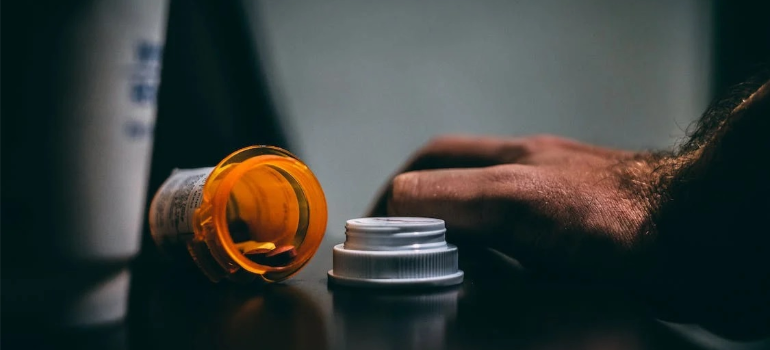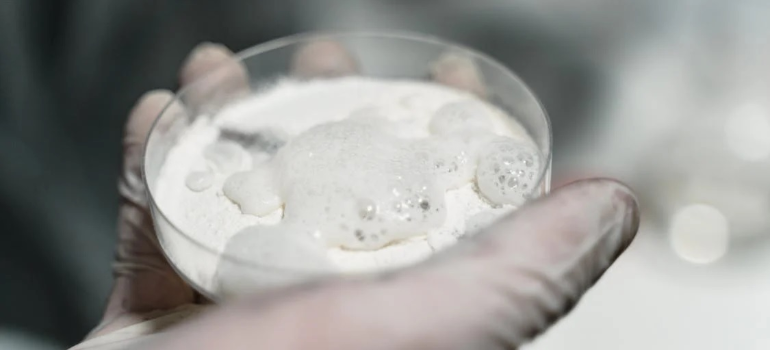Polydrug Abuse Facts – Dangerous Drug Combinations
Get Help Now
Addiction can unfortunately occur for a variety of reasons. Prolonged and unmonitored use of prescription drugs, self-medication, recreational use of illicit substances, and other circumstances can lead to the development of Substance Use Disorders (SUDs). Across the US, the ongoing opioid epidemic and drug overprescriptions are contributing to SUD-related health complications and deaths.
A commonly overlooked element of SUDs is that they may often overlap with others. For example, an individual with an opioid addiction may also be abusing depressants – with considerable risks to their health. At Archstone Behavioral Health, our rehab center in Lantana has often welcomed and treated such cases.
For this reason, today we would like to explore the subject of polydrug use and co-occurring SUDs. We have gathered the most notable polydrug abuse facts and dangerous drug combinations, alongside relevant statistics our readers may find of use.
Introduction to polydrug use and polydrug abuse facts
Initially, let us take a moment to explore the phenomenon of polydrug abuse and outline its key facts.
What is polydrug use?
As the name suggests, “polydrug use” refers to using multiple drugs at the same time – or at least two. This can be any combination of the following:
- Different prescription drugs, when not all drugs used are prescribed or used as prescribed
- Different illicit drugs, such as cocaine and heroin
- Legal substances, such as alcohol, with prescription drugs or illicit drugs
Understandably, polydrug use does not cover using multiple legal substances as prescribed or instructed by medical professionals. Such cases are only technically polydrug use, and don’t endanger the individual’s health.

A common example of polydrug use is combining marijuana, a more socially acceptable substance with full or mixed legal status in many states, with prescription drugs or illicit drugs. This type of polydrug use is a fairly common encounter in marijuana detox Florida centers, albeit not the most common type.
Depending on the context and the intended meaning, as regards the individual’s health risks, this practice has such names as:
- Polysubstance abuse or polydrug abuse
- Multiple drug use or multiple substance use
- Combined drug use
How common is polydrug use?
The exact frequency of this practice is debatable, as is the value in quantifying it. That’s because different drug combinations carry different frequency rates and different health risks, so simply summing up all instances of this practice seldom feels valuable.
Still, frequency is among the most relevant polydrug abuse facts, and it does warrant some exploration. Which specific combinations are most notable will also warrant its own sections later in this article.
A few different data points may offer a better overview of polydrug use’s frequency. An initial one comes from ResearchGate, which finds that there was significant overlap among:
- Alcohol use disorder (AUD)
- Nicotine use disorder (NUD)
- Cannabis use disorder (CUD)
- Nonmedical prescription opioid use disorder (NMPOUD)
Another comes from the CDC, which notes last-year co-use trends among adults using methamphetamine within the past year. Specifically, “estimated prevalences of past-year use or misuse of other substances included”:
- Cannabis use – 68.7%
- Binge drinking – 46.4%
- Nicotine dependence – 44.3%
- Prescription opioid misuse – 40.4%
- Cocaine use – 30.4%
- Prescription sedative or tranquilizer misuse – 29.1%
- Prescription stimulant misuse – 21.6%
- Heroin use – 16.9%
A third and final one comes from NCBI, where a study on “New York City club-going drug-using young adults” found that:
“Most participants (91.7%) had engaged in polydrug use and 1,670 combinations of drugs were reported. Ecstasy (86.6% of users) and cocaine (85.7% of users) were the two most frequently reported club drugs used in combination with other substances.”

Common reasons for polydrug use
Finally, there are three primary reasons for polydrug use:
- The user wants to amplify a substance’s euphoric effects and combines it with a similar one, or
- The user wants to combat a substance’s effects and combines it with a different one, e.g., a depressant and a stimulant, or
- Unaware of the existence of another substance, the user accidentally engages in polydrug use, e.g., consuming fentanyl laced in heroin
Regardless of the exact reasons, however, polydrug abuse is always a highly dangerous practice – as we’ll see next.
Polydrug abuse facts – the dangers
Having operated the center for medical detox in Florida for years, we have seen the dangers of polydrug abuse manifold. Chief among them are the following.
#1 Immediate impact on health
First and foremost, polydrug abuse is immediately dangerous to the individual’s health and well-being. Naturally, exact symptoms will vary depending on such factors as:
- The individual’s overall health
- Possible tolerance to specific substances or substance combinations
- The potency of the substances consumed
- Exact dosage
- Exact substances combined
That said, physical symptoms will typically be severe, and can include:
- Brain damage or coma
- Heart problems
- Seizures
- Stomach bleeding
- Liver damage or liver failure
- Heatstroke
- Suppressed breathing or respiratory failure
In addition, psychological symptoms can include:
- Anxiety
- Depression
- Irritability and restlessness
- Paranoia
- Self-harm or suicide ideation
As such, while the exact impact of polydrug use can vary, its potential dangers cannot be overstated.

#2 Overdose risks
In addition to such health risks as the above, overdose risks are also much higher with polydrug use. Combining different substances makes it harder to keep track of individual doses, for one, but some combinations can also amplify each individual substance’s adverse effects. In addition, such effects as those of depressants can make it harder to seek immediate medical help once overdose symptoms present themselves.
To illustrate the tremendous impact of these factors, here we can cite polydrug abuse facts as outlined by the CDC:
- In 2019, “nearly half of drug overdose deaths involved multiple drugs”. This staggering number should leave little room for doubt; polydrug abuse can be deadly.
- In 2020, “opioids were involved [in] 8% of all drug overdose deaths”. A direct effect of the ongoing opioid crisis, opioids remain lethal and now find their way to polydrug use.
- “U.S. overdose deaths [were still up 15% in 2021]”. While the increase was lesser than that of 2020, overdose deaths remained high in 2021 – with polydrug abuse playing its role.
For additional context on specific lethal combinations, NIDA offers a detailed breakdown of substance combinations involved in overdose deaths. Among others, consider the following relevant examples of polydrug overdose and death from 2020:
- Almost half of all 16,416 opioid deaths involved both prescription and synthetic opioids (other than methadone).
- Of 13,165 deaths involving heroin, a synthetic opioid, more than two-thirds involved combinations with other synthetic opioids.
- Of 23,837 deaths involving psychostimulants, nearly half involved combinations with synthetic opioids (other than methadone).
These statistics, too, leave little room for doubt. Polydrug use carries significant overdose risks, which is unfortunately consistently reflected in overdose deaths nationwide.

#3 Effects on rehabilitation
Third, the above polydrug abuse facts aside, polydrug abuse has another crucial element related to rehabilitation. Virtually every inpatient drug detox center Florida offers can attest to the fact that recovering from polydrug abuse is considerably harder.
This is due to a few different reasons, the primary of which include:
- More powerful withdrawal symptoms. Detoxing from multiple substances at once can often produce much more severe withdrawal symptoms, making the detox phase particularly challenging.
- More potential damage. Many substances cause damage to the body, such as weight loss or gain and dental damage. Others can cause psychological damage, such as kindling depression and anxiety. Polydrug use can exacerbate such harm, and make a recovery more complex.
- Co-occurring addictions. Treating addictions to two or more substances is also distinctly harder than treating individual addictions. It often requires different medications, a stronger focus on psychotherapy, and a much more tailored rehabilitation plan. Not every addiction treatment provider is ready or equipped for this challenge.
In brief, polydrug abuse is so harmful that it has the natural consequence of requiring deeper, more thorough treatment.
#4 Polydrug use and dual diagnosis
Lastly, on the subject of rehabilitation, polydrug use also often complicates mental health treatment. As highlighted above, substances often adversely affect mental health – which polydrug abuse facts only exacerbate.
The phenomenon of co-occurring mental health disorders and SUDs is dubbed dual diagnosis, and understandably requires specialized treatment approaches. In such cases, rehabilitation must treat both substance addiction and underlying mental health disorders. It is often unclear which condition caused the other, but both require treatment.

Dual diagnosis is also unfortunately common. NIDA finds that 37.9% of adults with SUDs also have mental illnesses and that 18.2% of adults with mental illness also have an SUD. In addition, the CDC finds stronger ties to specific substances such as methamphetamine, noting that “an estimated 57.7% [of persons who used methamphetamine] reported any mental illness, and 25.0% reported serious mental illness during the past year”.
Polydrug abuse also impacts dual diagnoses by combining the potentially harmful effects of multiple substances on mental health. In turn, a higher likelihood of a dual diagnosis also makes addiction treatment harder.
Polydrug abuse facts – dangerous drug combinations
Finally, while all polydrug use is dangerous, some specific combinations come with higher risks. The most notable ones regarding mixing different drugs, are the following:
Mixing alcohol with other substances
Alcohol is among the most common substances to mix with illicit drugs, and among the most dangerous ones. Treatment-wise, alcohol withdrawal medication often accounts for this.
Alcohol and heroin
Alcohol and heroin function in similar ways, as they’re both Central Nervous System (CNS) depressants. In combination, they increase the likelihood of such life-threatening symptoms as:
- Impaired breathing or respiratory failure
- Decreased blood pressure
- Decreased oxygenation of the brain, which can cause brain damage
Alcohol and benzodiazepines
Similarly, combining alcohol with benzodiazepines has similarly amplified CNS depression effects. Xanax detox Florida providers can attest to the frequency and potential lethality of this substance combination, as its effects include increased risk for:
- Impaired breathing or respiratory failure
- Coma
- Death
Alcohol and cocaine
In contrast, mixing alcohol and cocaine does not seek to amplify depressive symptoms. Instead, cocaine acts as a counter to alcohol’s depressive symptoms, as it is a stimulant.
The danger of this combination is far more specific and comes down to the liver metabolizing both substances at once. In doing so, it produces cocaethylene, which increases euphoria but also comes with such side effects as increased blood pressure and aggression. If it builds up to toxic levels, it can also cause sudden death.
Additional risks of this combination include:
- Heart disease, heart attacks, and cardiac arrhythmia
- Necrosis of blood vessels and brain tissue, leading to brain damage, stroke or aneurysm
- Intracranial hemorrhage
Mixing cocaine with other substances
Cocaine is another popular substance to mix with others. Being a powerful stimulant by itself, polydrug abuse facts suggest these combinations can also be highly dangerous.

Cocaine and heroin
One of the most common cocaine combinations is with heroin. This combination is dubbed “speedball”, and has a similar intent as that of cocaine with alcohol; to suppress the stimulating effects of cocaine or to add euphoria to the relaxing effects of heroin.
Cocaine withdrawal treatment often has to account for “speedballs”, unfortunately, as this combination can have such symptoms as:
- Bluish skin or fingernails
- Extreme stomach pain
- Respiratory depression
In addition, this combination can be particularly lethal. This is common because the individual loses inhibitions and fails to understand the effects of their heroin dosage.
Cocaine and ecstasy
Another cocaine combination that seeks to amplify euphoric, stimulating effects is that of cocaine and ecstasy, or MDMA. This combination can notably cause serotonin syndrome, resulting from too much serotonin accumulated in the brain. Its symptoms can include:
- Mental confusion
- Muscular problems
- Irritability and hyperactivity
- Fever and sweating
- Rapid heartbeat
- Muscle spasms
In severe cases, this combination can also lead to death. While relatively less common than other combinations, the high potential for overdose should not be overlooked.
Cocaine and fentanyl
Finally, a notably deadly combination comes in consuming cocaine alongside fentanyl. Fentanyl has a heroin-like effect, being a synthetic opioid with powerful pain relief qualities. As highlighted above, synthetic opioids contribute significantly to all overdose deaths.
As any opioid detox center Florida offers will attest to, fentanyl on its own has such powerful symptoms as:
- Intense euphoria
- Sedation
- Respiratory depression
Combined with cocaine, it poses similar risks as the “speedball” combination. In addition to them, however, fentanyl’s own lethality makes this combination one of the deadliest ones today.
Archstone Behavioral Health is here for you
In summary, polydrug abuse facts paint a highly alarming picture. The practice of combining substances to enhance or counter their effects is far from new, but recent years have seen a dramatic increase in health complications and overdose deaths because of it. The statistics above should help illustrate this danger of polydrug use, and our own experience confirms them.
If you or your loved ones need help with polydrug use or abuse, Archstone Behavioral Health is here for you. We have treated such cases manifold, and come fully equipped to tailor rehabilitation to each case’s unique needs. If you need additional information or want to seek help, please feel free to contact us today.